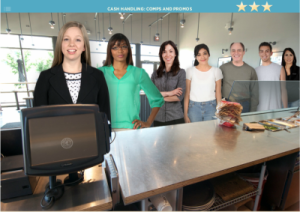 Hello fabulous folks! Here is a quick walk through of how to create a successful training experience by thinking through who to involve in the beginning. Below is a real example of a situation I faced…
Hello fabulous folks! Here is a quick walk through of how to create a successful training experience by thinking through who to involve in the beginning. Below is a real example of a situation I faced…
The business problem: Your company needs to increase cashiers accuracy on the Point of Sale system.
Business Goals:
- Increase order accuracy x% by x date
- Increase cash handling audit scores x% by x date
- Reduce customer complaints x% by x date
- Reduce revenue lost by improperly ringing up orders x% by x date
The learning problem
You’ve identified business goals (always make them measurable) and reviewed existing materials. What would be your next step? How will you know the pain points and WHY cashiers are having issues with ringing up sales, and what differentiates the successful vs less successful cashiers?
The solution…sort of
Right – talk to them! But, make sure you’re talking to the RIGHT people. Often, we talk to whoever is easiest to access. I know I have. When creating eLearning at Chipotle, and faced with this exact scenario, I started speaking with local restaurants to find the answers to these questions. The problem was – I wasn’t talking to the right people.
The REAL solution
After not getting answers I needed, I took a different approach. I decided to start with the people who were INCREDIBLE at this topic. So, I worked with Finance to run a report to identify which restaurant had the highest cash handling audit score for the longest period of time. After identifying the restaurant, I visited them.
Discovering the answers – The Visit
During the visit, I asked questions to uncover what made this particular restaurant so great at cash handling. I observed and documented their process, noticing things the cashier did, such as asking the manager things like ‘Do we have any specials I should be aware of?’ before starting their shift, and reference sheets they had created, etc. As I worked the cash station, a few things I noticed were:
- The anxiety that so many new cashiers probably feel, as the line went out the door and how fast it went depended on me – Ahhhh!!
- The frantic experience that occurs when things aren’t marked properly, like a burrito, and trying to determine what kind of burrito it was, so I could ring it up properly
- Before you get on the cash station, you should memorize how to ring up most of the popular items!
This experience would help craft the training experience for every new cashier, going forward – setting them up for success.
The end result
The end result was a fully interactive scenario-based experience that allowed learners to help customers, memorize ringing up the most popular items on the POS system, deal with a variety of situations that occur, adhere to policies (like the liquor policy), and become confident in themselves before even stepping up to the cash register.
Understanding not only how to perform the job, but also how it felt and the emotions experienced while doing it, helped me carefully craft an effective training solution and incorporate things I may not originally have thought of (like throwing in unmarked items for the learner to deal with or being unable to tell whether a coupon is real or not).
While there are other things to consider, like speaking with folks who are struggling, to understand their pain points, gleaning information from SME’s (I observed a cash handling audit to determine what they look for), etc., simply spending some time with those who do it right will go a LONG way in ensuring your training meets the business goals.
What if you don’t have access to the learners?
Sometimes this happens! You can create a survey for learners and ask things like ‘How did you feel your first day doing this? Did you have any anxiety over certain tasks – if so, which ones? How did you overcome that?’ Or, ask SME’s these questions, if they are close enough to the ground level to be able to answer them. Questions might include ‘What are the key differences between those who are successful at x than those who are less successful?’ and ‘What emotions might someone experience while doing x for the first time?’
What are some ways you ensure that the training experience you craft connects to learners and sets them up for success?
